Interpretive, Interpersonal, and Presentational Modes of Communication
Exploring Culture
In Spanish 102, I completed multiple Competencia Cultural assignments that helped me to gain a better understanding of Hispanic culture. These assignments involved watching a short video of a narrator discussing a specific aspect of Hispanic culture, such as food, or what people like to do after work. After watching the video, I would answer a few questions related to what I saw.
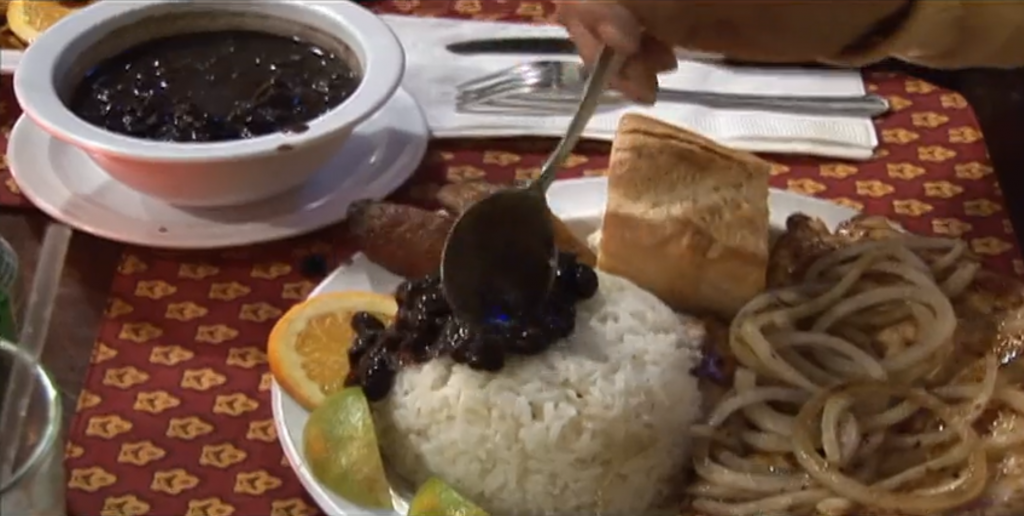
Mojito: a Cuban dish with chicken, white rice, black beans, and fried plantains. Food was the focus of one of the Competencia Cultural assignments
I enjoyed learning about the many different dishes enjoyed in Hispanic culture. Usually, when I think about Hispanic food, I only think of foods such as tacos and enchiladas. In this video, however, I learned about many different dishes, such as mojito, ropa vieja, and picadillo.
Another thing that I learned about were the outdoor markets in Costa Rica. These were places where vendors could come to sell their products, and shoppers could come to enjoy a great selection of anything from shoes, to meat, to banana peels. Something that I found very interesting about these markets was how common it was to bargain. In the United States, everything has a fixed price, but in these markets in Costa Rica, everyone is willing to bargain.
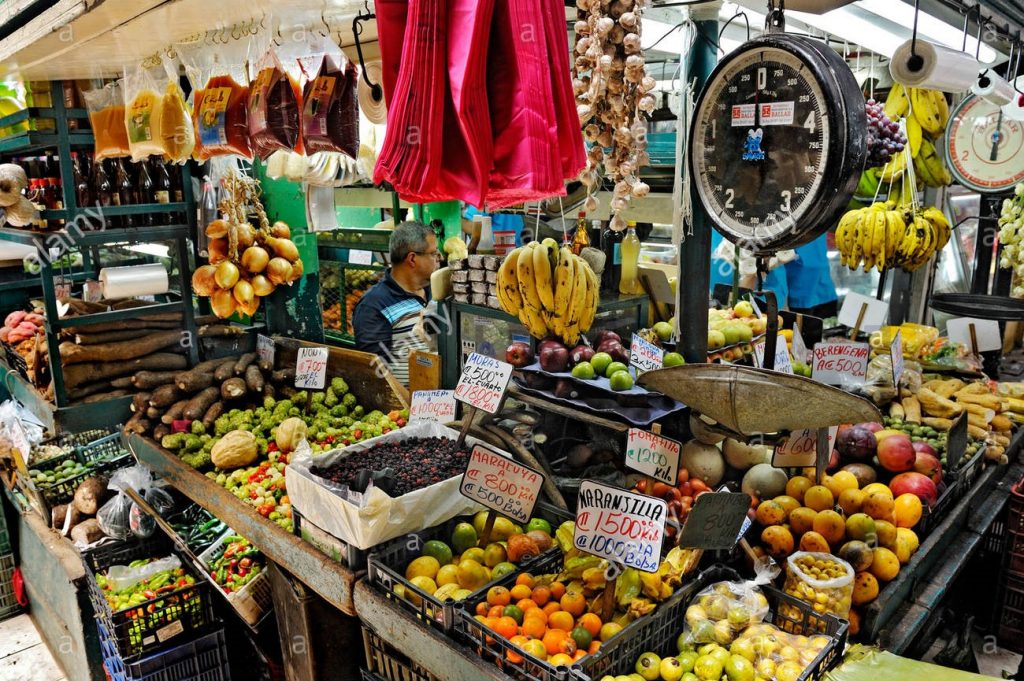
The Central Market in San José, Costa Rica. Markets in San José were the focus of one of the Competencia Cultural assignments
Interpersonal Communication
In Spanish 102, I completed numerous interpersonal communication activities. I participated in informal conversational activities in class, I completed an interview with my professor, and I also had a conversation over TalkAbroad. For my TalkAbroad conversation, I spoke for fifteen minutes entirely in Spanish with a native speaker from Argentina. We spoke about food, daily routines, school, and more. I enjoyed this conversation, and it also gave me an opportunity to learn about the differences in schooling between Argentina and the United States. I was surprised at how much vocabulary I understood during this conversation. However, I think I made a lot of grammatical mistakes, and also paused frequently in my speech. I think these are things that I could definitely improve on for next time. Overall, I think this experience was beneficial to my understanding of Spanish, and it is something that I would love to do again.
Presentational Speaking
I did not complete any formal presentational speaking in Spanish 102. However, I did a few informal presentational speaking activities in class. For example, I did an activity with a partner where we composed a short dialogue directed at an imaginary child, and presented it to the class.
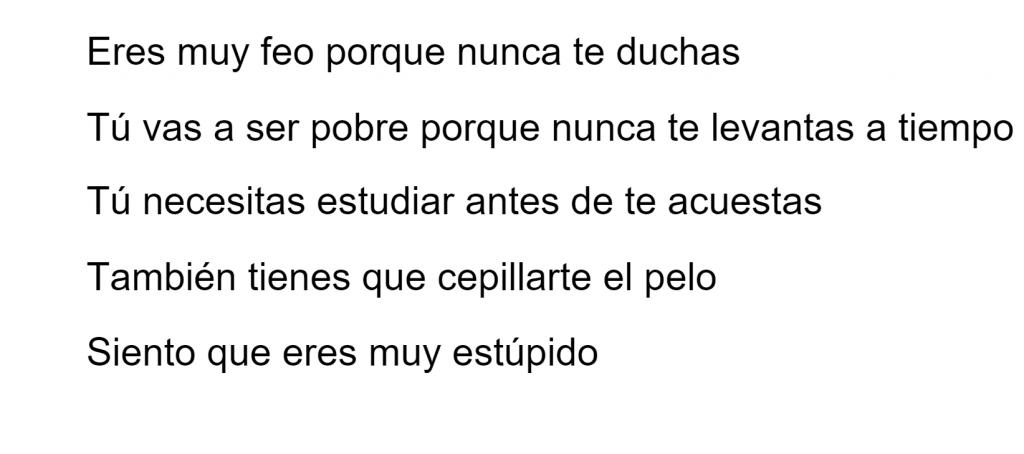
An excerpt from the script of one of the presentational speaking activities that I did in class with a partner
The most difficult part of these activities for me was pronunciation. I sometimes have trouble pronouncing words correctly in Spanish, and I especially have trouble rolling my r’s. For this reason, I lack confidence in speaking Spanish, especially in front of the whole class. I overcame this by appreciating that we are all there to learn, and the only way to improve is to practice, even if it is uncomfortable at first.
Presentational Writing
In Spanish 102, I completed two compositions, which were short essays written entirely in Spanish. Each composition was about half of a page long, and was written on a designated topic decided by my instructor. My first composition was a brochure for an imaginary hotel. My second composition was a description of what my daily routine would look like if I lived on a deserted island.
El-Hotel-de-oceano-2The final copy of my first composition, which was a brochure for an imaginary hotel. (Click the arrow at the bottom to see the second page)
For each composition, I created a rough draft and a final copy. After submitting my rough draft, my professor pointed out any mistakes that needed to be corrected. In the rough draft of my first composition, I made a few mistakes regarding grammar and choice of words. For example, I used the phrase “O puedes nos llamada” instead of “O nos puede llamar”. I learned a lot of new grammar in Spanish 102, which allowed me to express many new thoughts and ideas, but was also very confusing at first, which is why I made a few grammatical errors. Overall, I enjoyed creating this composition. I appreciated the creative and design aspects of this assignment, as opposed to writing on blank paper. It also compelled me to think critically about the vocabulary that I learned, and apply it in a more realistic way.

The rough draft of my second composition, which was a description of my daily routine on a deserted island.
By the time I wrote my second composition, I had gained a better understanding of Spanish grammar and sentence structure, and I only made one grammatical error. I also think that the second composition was easier for me because the vocabulary and grammar that I was required to use was simpler. I made one grammatical error on my second composition, but overall I think that I effectively conveyed what I was trying to say while using proper grammatical conventions.
Interpretive Listening
In Spanish 102, I completed numerous interpretive listening activities, including homework assignments on VHL and Competencia Cultural assignments. The Competencia Cultural assignments involved watching a short video with a narrator explaining various aspects of Hispanic culture. Some of these videos were spoken entirely in Spanish, others had a bit of English narration. The interpretive listening VHL homework assignments were typically audio clips accompanied by a list of true or false questions relating to the information in the audio.
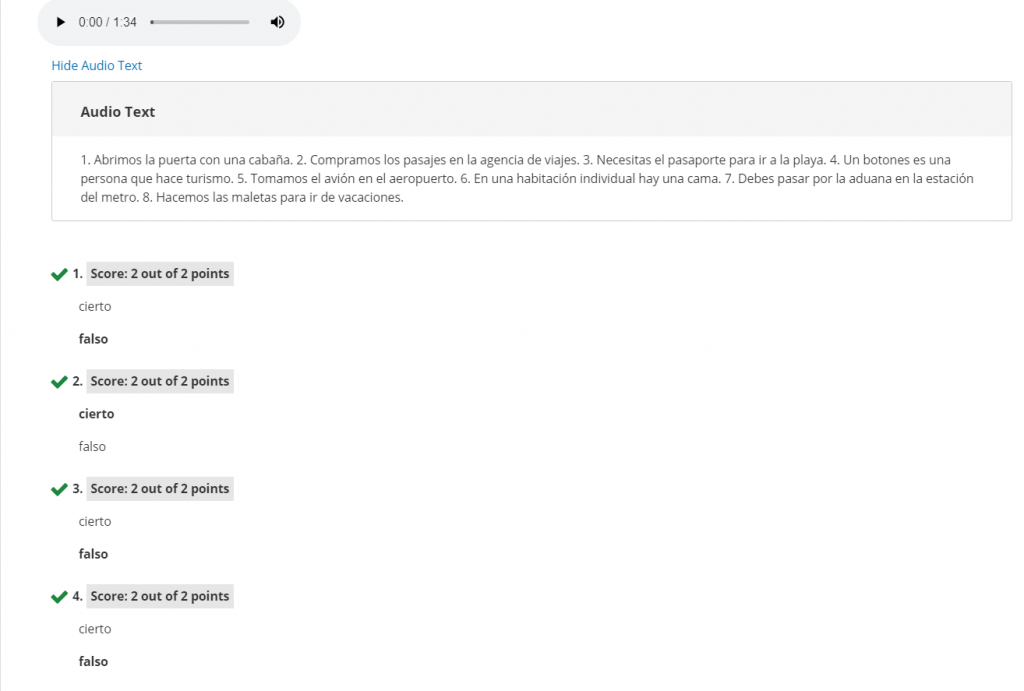
One of the many VHL homework assignments that involved interpretive listening. The text that is shown above does not become available until after the assignment has been submitted.
The Competencia Cultural assignments that I completed this semester definitely challenged my interpretive listening skills. Most of them were spoken entirely in Spanish, and were spoken at a rapid pace. This made it difficult to understand at times, as I didn’t have time to translate each word in my head. I also didn’t understand all of the vocabulary used in these videos. One thing that helped me improve was to read the Spanish transcript, translate any words that I didn’t know, and then listen to the video again. This way, I already knew what words were being spoken, and I just had to listen for them. I found that the interpretive listening assignments on VHL were easier to understand, because they were spoken at a slower pace, and only used vocabulary that I had previously learned. Overall, I think I improved a lot at interpretive listening this semester. Another thing that helped me improve was watching television with Spanish audio and subtitles.
Interpretive Reading
In Spanish 102, I completed multiple Lectura assignments, involved reading some sort of composition, such as a brochure, a restaurant review, or a comic, written entirely in Spanish. After reading the composition, I would answer a few questions related to the content.
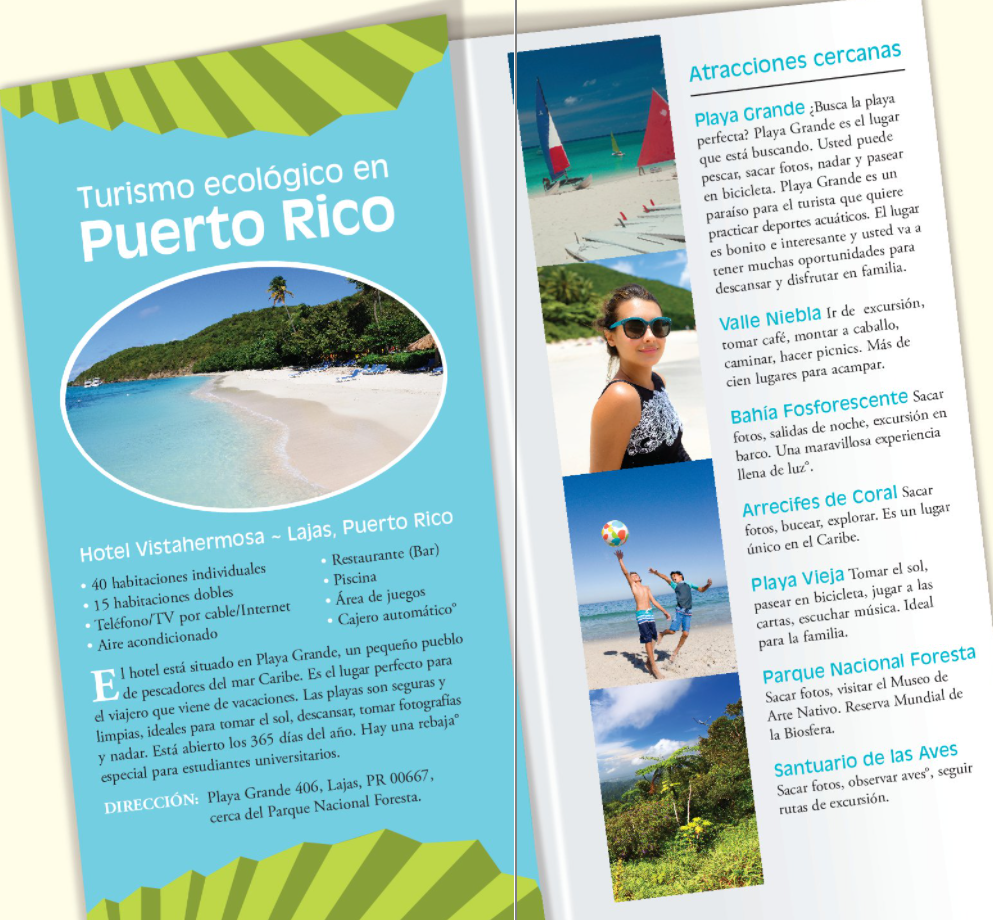
The composition that I read for my first Lectura assignments, which was a brochure for a hotel
Lectura assignments were also something that I completed in Spanish 101, but this semester, I was able to understand and comprehend much more written Spanish than I could before. Previously, when completing Lectura assignments, I had to use a translating tool for many words in the composition. Now, however, I can understand almost all of the vocabulary that I encounter in Lectura assignments. And when there is a word that I cannot understand, I can usually infer the meaning based on context.